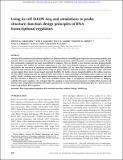| dc.contributor.author | Watters, Kyle E. | |
| dc.contributor.author | Gasper, Paul M. | |
| dc.contributor.author | Abbott, Timothy R. | |
| dc.contributor.author | Carlson, Paul D. | |
| dc.contributor.author | Chen, Alan A. | |
| dc.contributor.author | Lucks, Julius B. | |
| dc.contributor.author | Takahashi, Melissa Kimie | |
| dc.date.accessioned | 2017-07-26T15:25:30Z | |
| dc.date.available | 2017-07-26T15:25:30Z | |
| dc.date.issued | 2016-04 | |
| dc.date.submitted | 2015-10 | |
| dc.identifier.issn | 1355-8382 | |
| dc.identifier.issn | 1469-9001 | |
| dc.identifier.uri | http://hdl.handle.net/1721.1/110853 | |
| dc.description.abstract | Antisense RNA-mediated transcriptional regulators are powerful tools for controlling gene expression and creating synthetic gene networks. RNA transcriptional repressors derived from natural mechanisms called attenuators are particularly versatile, though their mechanistic complexity has made them difficult to engineer. Here we identify a new structure–function design principle for attenuators that enables the forward engineering of new RNA transcriptional repressors. Using in-cell SHAPE-Seq to characterize the structures of attenuator variants within Escherichia coli, we show that attenuator hairpins that facilitate interaction with antisense RNAs require interior loops for proper function. Molecular dynamics simulations of these attenuator variants suggest these interior loops impart structural flexibility. We further observe hairpin flexibility in the cellular structures of natural RNA mechanisms that use antisense RNA interactions to repress translation, confirming earlier results from in vitro studies. Finally, we design new transcriptional attenuators in silico using an interior loop as a structural requirement and show that they function as desired in vivo. This work establishes interior loops as an important structural element for designing synthetic RNA gene regulators. We anticipate that the coupling of experimental measurement of cellular RNA structure and function with computational modeling will enable rapid discovery of structure–function design principles for a diverse array of natural and synthetic RNA regulators. | en_US |
| dc.language.iso | en_US | |
| dc.publisher | Cold Spring Harbor Laboratory Press | en_US |
| dc.relation.isversionof | http://dx.doi.org/10.1261/rna.054916.115 | en_US |
| dc.rights | Creative Commons Attribution 4.0 International License | en_US |
| dc.rights.uri | http://creativecommons.org/licenses/by/4.0/ | en_US |
| dc.source | Cold Spring Harbor Laboratory Press | en_US |
| dc.title | Using in-cell SHAPE-Seq and simulations to probe structure–function design principles of RNA transcriptional regulators | en_US |
| dc.type | Article | en_US |
| dc.identifier.citation | Takahashi, Melissa K., Kyle E. Watters, Paul M. Gasper, Timothy R. Abbott, Paul D. Carlson, Alan A. Chen, and Julius B. Lucks. “Using in-Cell SHAPE-Seq and Simulations to Probe Structure–function Design Principles of RNA Transcriptional Regulators.” RNA 22, no. 6 (April 21, 2016): 920–933. | en_US |
| dc.contributor.department | Massachusetts Institute of Technology. Institute for Medical Engineering & Science | en_US |
| dc.contributor.mitauthor | Takahashi, Melissa Kimie | |
| dc.relation.journal | RNA | en_US |
| dc.eprint.version | Final published version | en_US |
| dc.type.uri | http://purl.org/eprint/type/JournalArticle | en_US |
| eprint.status | http://purl.org/eprint/status/PeerReviewed | en_US |
| dspace.orderedauthors | Takahashi, Melissa K.; Watters, Kyle E.; Gasper, Paul M.; Abbott, Timothy R.; Carlson, Paul D.; Chen, Alan A.; Lucks, Julius B. | en_US |
| dspace.embargo.terms | N | en_US |
| mit.license | PUBLISHER_CC | en_US |
